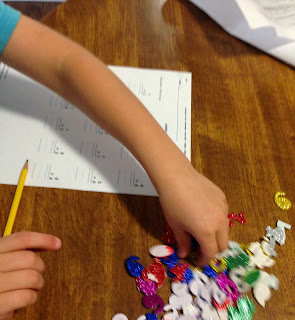Advent starts in one week! Last year, I shared a simple advent calendar that I developed for my own kids. Looking at it last night, I realized that my visual skills have improved in the last year. One more benefit of blogging! Sorry, I took the embarrassing "before" evidence down, so you can't go look. However, I am re-doing the post in case someone might find the content helpful.
Here are the the themes and verses we will look at each week during the month leading up to Christmas.
Week One: The Promises of Christmas
1. To Abraham: Genesis 12:3, Genesis 17:19, Genesis 22: 18; Page 56 in the Jesus Storybook Bible by Sally Lloyd-Jones.
2. To David: 2 Samuel 7:16, Psalm 22; Page 116 in the Jesus Storybook Bible
3. To Micah: Micah 5:2, cf. Matthew 2:6
4. To Isaiah: Isaiah 7:10 and Matthew 1:23, Isaiah 9:1,2 and Matthew 4:15,16, Isaiah 53:4 ; Page 144 in the Jesus Story book Bible.
I like using the Jesus Sotrybook Bible for this first section of advent because Sally Lloyd-Jones does such a lovely job of tying together the themes of the Old Testament with the coming of Christ. For the rest of the calendar, I find reading directly from Scripture alone connects well with my children.
Week Two: Songs of Christmas
1. Elizabeth's song: Luke 1:42-45
2. Mary's song: Luke 1:46-55
3. Zacahraias's song: Luke 1:68-79
4. Simeon's song: Luke 2:28-32
Week Three: Comings of Angels at Chrstimas
1. To Zacharias: Luke 1:5-24
2. To Mary: Lukie 1:26-38
3. To Joseph: Matthew 1:19-25, Matthew 2:13, 19
4. To Shepherds: Luke 2:8-14
Week four: The Baby Jesus
1. The Word: John 1:14
2. The King: Matthew 1:25, Matthew 2:11
3. The Baby: Luke 2:1-7
4. The Savior: Luke 2:15-20
Last night I made up figures for each week, and printed four of each of the figures with one set of verses on each. Both of my kids will get a figure to decorate if they like, then paste on their own calendar. We will talk about one figure on each of our normal school days during calendar time. You could also use this calendar as a basis for a weekly lesson that focuses on one of these themes each week.
My figures are super simple, (maybe I'll figure out beautiful by next year?), but they are available in the form of a free printable!
To down load a copy of my PDF of Advent Calendar Tokens, click here.
I hope that your Christmas is full of Wonder at the Gift sent from Heaven.














































